#Nigeria 2017
Explore tagged Tumblr posts
Text

Façade decoration of a house in Kano, Northern Nigeria. The design in moulded mud plaster includes a sword, a rifle and a dagi or 'endless knot'. 1984. Photographer: Paul Oliver (1927–2017) From the book Dwellings: The House Across the World, 1987.
2K notes
·
View notes
Text
TBR TAKEDOWN: GOODREADS, WEEK 8b
Akata Witch (The Nsibidi Scripts #1) by Nnedi Okorafor


I'm trying to trim down my tbr list(s) and I'm asking for your help! Descriptions and more info under the cut. Please reblog and add your thoughts!
* * * * *
Akata Witch weaves together a heart-pounding tale of magic, mystery, and finding one's place in the world.
Twelve-year-old Sunny lives in Nigeria, but she was born American. Her features are African, but she's albino. She's a terrific athlete, but can't go out into the sun to play soccer. There seems to be no place where she fits in. And then she discovers something amazing--she is a free agent with latent magical power. Soon she's part of a quartet of magic students, studying the visible and invisible, learning to change reality. But will it be enough to help them when they are asked to catch a career criminal who knows magic too?
Ursula K. Le Guin and John Green are Nnedi Okorafor fans. As soon as you start reading Akata Witch, you will be, too
Date added: 2017
Goodreads: 4.03
Storygraph: 4.01
PRO:
Liked Okorafor's Binti series
Magic school quartet?!
Entire series available from the library in my preferred format (audiobook)
CON:
YA/MG, younger than I typically look for these days
25 notes
·
View notes
Text

FELA KUTI Toronto 1989
Even though it went unpublished anywhere for over twenty-five years, my 1989 portrait sitting with Nigerian musical legend Fela Kuti is probably one of my most important shoots. It happened because, to put it plainly, I wanted it to happen, and did my level best to make it happen. I was a fan and had photographed Fela at a press conference here in 1987, doing publicity for a concert that ended up not happening for two more years. I was in a bit of a lacuna in my career when a new concert was announced, first at a soccer stadium not far from where I lived, before it was moved to the old Masonic Temple downtown, also known as the Concert Hall. I wasn’t shooting regularly for any publication at the time, so I was working strictly on spec when I contacted Gary Froude, the promoter of the show, to see if I could get permission not just to photograph the concert but possibly a few minutes for a portrait sitting. To my surprise he said yes.





Fela Anikulapo Kuti was born to a prosperous family in Nigeria in 1938 and made his name with Africa 70, his first big band, attracting the attention of musicians like Ginger Baker and Paul McCartney. He also became a vocal opponent of Nigeria’s government, criticizing them as he recorded prolifically, on albums like Confusion, Expensive Shit, Zombie, No Agreement and many others. In 1977 his Lagos compound was raided; Fela as beaten severely and his mother was fatally injured when she was thrown out a window. By the end of the decade he’d formed a new band, Egypt 80, and began releasing records like Army Arrangement and Teacher Don’t Teach Me Nonsense on labels in Europe and America. The Nigerian government jailed him on charges of currency smuggling in 1984, and in 1986 he performed at an Amnesty International concert in Giants Stadium. But ticket sales for his show in Toronto in 1989 were slow, forcing it to be moved to a smaller venue; I’m not sure the promoter made any money on it, but I remember it as one of the best concerts I have ever seen.








I showed up to photography Fela Kuti around soundcheck and set up my modest lighting in a big dressing room in the basement of the Concert Hall on Yonge Street. Most of all I remember that Fela was one of the most intimidating men I have ever met, and that we began the portrait sitting with a series of rather straightforward shots on my Mamiya C330 camera. After finishing a roll Fela signaled for a break; he stretched out on a couch and began smoking the largest joint I had seen in my life for over a half hour. When the portrait session resumed he was, as I once wrote, rather heroically stoned, and these photos were far looser, as Fela glowered and pulled at his face. I’ve included every worthwhile frame I shot that afternoon on this post – the first time many of these shots have ever been published. Fela Kuti died of complications from AIDS in 1997.








I returned that night to shoot the show, going through several rolls of colour and black and white film, after which everything sat in my files for over two decades until I posted a few shots on my old blog. They came to the attention of Rikki Stein, Fela’s onetime manager, who arranged for them to appear for the first time in a 2017 box set of Fela’s records curated by Erykah Badu. Since then my Fela shots have been reprinted frequently; they were featured as part of a nightclub set on the Netflix reboot of the prime time soap Dynasty, on a line of t-shirts made by Carhartt, and in a Fela exhibit in Paris in 2023. Last year one of my live shots of Fela was on the cover of the debut issue of Rolling Stone Africa, which felt like vindication for that spec shoot I’d begged to do almost four decades ago. (Though I still wish they’d gone with one of these portraits.)





#portrait#portrait photography#photography#black and white#film photography#some old pictures i took#fela kuti#mamiya c330#early work#rolling stone magazine#rolling stone africa#afro beat#fela#fela anikulapo kuti
12 notes
·
View notes
Text
Twenty Years of Habitual Lying
Everytime they "reinvent" themselves, we the public are expected to just tolerate The Meghans penchant for lying. The truth is that Meghan and Harry lie about EVERYTHING.
Poll Question: Based on online document searches for archived copies of Evanston's Northwestern University Commencement Programs, what YEAR (over 100 years) generates the MOST online interest?
Terminal Condition

Diagnosis

Truthers whose websites were shuttered in 2017

Royal Reporters who still can't be bothered to fact check sussex content

Political Science Department at Northwestern University

Colombia, Nigeria, Jamaica, South Africa, Australia, Ireland, Great Britain...

Everyone with a working brain recognizes this as deception: "since I grew up in the states, I didn't grow up with the same understanding of the royal family, while I NOW understand there is a global interest, I didn't really know much about him." Anyone who legitimately studied International Relations would feel embarrassed at the thought of pretending not to know about a global interest in monarchies. Not to mention all the BRF related activities she participated in throughout adolescence and in her career as a working actress in a Commonwealth Country.

#1 Question for all of MegaLiar's so-called friends: What is your excuse?

#poll question#MegaLiar#meghan markle is a liar#voetsek meghan#spare us#traitor prince#pinky and the brain#megxit#Northwestern University should be embarrassed#fraud#communications is NOT international relations#20 years of lies#expose meghan markle#meghan and harry are toxic#deception#deceivers#mao's wife#star to be#manifesting stardom#Northwestern graduation#communications
19 notes
·
View notes
Text
Meet the Nigerian women spearheading solar projects

32-year-old green energy entrepreneur Yetunde Fadeyi will never forget what inspired her to start a clean energy company in Nigeria.
As a six-year-old, Fadeyi’s best friend, Fatima, was killed by carbon monoxide poisoning in her Lagos home, along with her father and pregnant mother.
“She often came over for sleepovers. But that day she didn’t,” says Fadeyi. “It was the time that they were stealing people’s generators, so they kept [the generator] in an enclosed area and by the time it was morning they were dead.”
After a childhood in Lagos plagued by intermittent electricity, a degree in chemistry and training in solar panel installation, Fadeyi started Renewable Energy and Environmental Sustainability (REES). The non-profit is dedicated to climate advocacy and providing clean energy to poor communities in rural Nigeria.
Bringing solar energy to Nigeria’s poorest homes
Since its inception in 2017, REES Africa has provided solar energy to over 6,000 people in the poorest parts of Nigeria, funded by grants and philanthropic donations.
It supplies solar microgrids, which generate energy through solar panels and store them in battery banks for distribution. The small grids bring high quality, cheap and constant power to up to 100 homes each, powering light bulbs, radios, sockets and other low energy appliances.

Fadeyi says that energy companies don’t see any potential for profit in poor and marginalised communities. With around 40 per cent of Nigerians living below the national poverty line, it’s up to companies like Fadeyi’s to fill the gap for now.
Professor Yinka Omoregbe is hoping to bridge this energy gap as CEO of Etin Power, providing energy to offgrid communities using mini solar grids. She brings a wealth of experience to the role as a former national advisor on the reform of Nigeria’s petroleum sector and a former state attorney general.
In its first year, Etin Power provided electricity to over 5,200 people in three neglected coastal communities in Edo State, southern Nigeria. While the results so far are small, Omoregbe’s ambitions are far bigger.
We will have proven that it is possible to profitably give green energy to vulnerable communities.”
#solarpunk business#solarpunk business models#solarpunk#solar punk#startup#africa#solar power#green energy#renewable energy#nigeria#entrepreneurs#women#woman
37 notes
·
View notes
Text
Ten years ago, Solomon Maina's daughter, Debora, was one of 276 schoolgirls kidnapped from their dormitory in the middle of the night by Nigeria's Boko Haram Islamist militants.
Global outrage was swift. A ubiquitous "Bring Back Our Girls" campaign, drawing support from the likes of Michelle Obama and Sylvester Stallone, shined a spotlight on the abductions. Then, in 2016 and 2017, negotiations led to the highly publicised liberation of around 100 of the captives.
Debora was not one of them.
A decade after that fateful night in April 2014, the world has largely forgotten the plight of the so-called Chibok girls.
But for the victims and their families, the tragedy is ongoing.
"Especially at night, I think about my daughter," Maina, in tears, told Reuters in an interview at his home in Chibok, a Christian enclave in the West African nation's majority Muslim north. "I will never forget her."
Abductees who have returned home have struggled to resume their interrupted lives. Some are raising children fathered by their captors. Others have waited years for funds promised by the government to continue their education.
Those who spent the longest time in captivity have often had the most difficulty reintegrating with civilian life.
Dozens freed only in the past few years are living inside a military-run rehabilitation camp with surrendered Boko Haram fighters they married in the bush, according to the Murtala Muhammed Foundation, a charity that advocates for them. With them are more than 30 children.
"I'm tired of staying in the camp," one Chibok survivor told Reuters, asking not to be identified for fear of reprisals by the military. "I want to go home and stay with my family. There is no place like home."
Three of the surviving women told Reuters that in at least five cases women who arrived at the camp unmarried have been married to surrendered fighters once there. Government officials have officiated over such weddings, in an apparent effort to appease the surrendered fighters, family members say.
Aid groups and relatives say there is no clarity surrounding when - or even if - the women in the camp will be allowed to return home.
"They were brainwashed and their psychological thinking and mindset were changed to favour their abductors," said Dauda Yama whose daughter is inside the camp.
The state official in charge of the rehabilitation project did not respond to a Reuters request for comment.
Still missing
Roughly 90 Chibok girls are still missing. Based on the accounts of former abductees, the Murtala Muhammed Foundation believes a third of those have died in captivity.
"Some died of childbirth, some of starvation or snakebite others in government air strikes" against Boko Haram, said Aisha Muhammed-Oyebode, the foundation's head. A parents association for the Chibok girls also estimates dozens are now dead.
Nigeria's president's office and the interior ministry did not respond to requests for comment on how many of the missing Chibok girls were believed to still be alive.
Early on, as the girls began emerging from captivity in the bush and their fate was still a rallying cause around the world, the government pledged to fund their studies in "any field of their choice."
Some liberated captives are attending universities as far afield as the United States. But some say the assistance never arrived.
Yagana Yamani waited for government funds for six years after escaping her captors. She finally asked her mother, a farmer, to help. Now 25, she is studying public health.
"They didn't fulfil their promise," she said.
The federal government did not respond to requests for comment on the question of whether it failed to provide promised support.
Nigeria's military has been fighting Boko Haram since 2009 in a conflict that killed tens of thousands of people and displaced more than 2 million.
While the group aims to topple Nigeria's government to establish a state based on its own interpretation of Islamic law, to many people around the world it is best known for the Chibok kidnapping.
Soon after the raid, then-President Goodluck Jonathan promised that the girls would be brought home. Solomon Maina feels he is alone grappling with his daughter's fate.
Through a freed abductee, he learned that Debora had been injured but survived a bombing raid on Boko Haram. He believes she's still out there, alive.
"Where is she now? Is she in a comfortable place?" he said.
"I think about this all the time."
15 notes
·
View notes
Text

DELTA-V by Daniel Suarez
RELEASE DATE: April 23, 2019
In the year 2032, heroic cave diver James "J.T." Tighe is recruited by shifty bitcoin billionaire Nathan Joyce for a daring undertaking in outer space.
As a private entrepreneur, Joyce is out to introduce asteroid mining in cis-lunar space (the area above Earth's gravity well), which, by establishing commerce there, will, he promises, pave the way for space travel. The rub is that Joyce will do anything to keep the project afloat, including breaking laws and keeping crucial details secret. Tighe and his fellow crew members, ranging from a young male electronics expert from Nigeria to a legendary female mountain climber from Argentina, are tested and trained on Ascension Island in the South Atlantic, where they are bound to a strict confidentiality clause and denied any personal privacy. By the time these handsomely paid adventurers make it "farther from Earth than any human beings in history," we learn about their varied backgrounds, particularly the lingering effects of Tighe's troubled past. Fatal accidents occur before a shocking death imperils the crew's return home. Suarez's (Change Agent, 2017, etc.) ability to keep things humming through low-key stretches as well as dramatic sequences reflects his skills as a writer. He makes a curious choice in quickly dropping the sexual tension arising from group showers, among other nude encounters. But Suarez is otherwise in admirable control. A cut above most tech novels, Suarez's latest benefits from his attention to detail, which boosts the believability of his futuristic vision.
6 notes
·
View notes
Text
Have You Heard Of?

“A man who would be intimidated by me is exactly the kind of man I would have no interest in.”
Chimamanda Ngozi Adichie b.September 15, 1977
Chimamanda Ngozi Adichie is an award-winning author and an influential advocate of feminism. She has captivated people worldwide with her powerful storytelling and her outspoken campaign for gender equality. She was born in Enugu, Nigeria, and was raised in an academic environment that surely nurtured her passion for writing. As one of six siblings she grew up in the university town of Nsukka, her Mother was the first female registrar at University of Masuka and her father was Nigeria's first professor of statistics, and later became Deputy Vice-Chancellor of the same university. She attributes her success in part to her parents for, encouraging her self-confidence and being supportive by always showing that they had confidence in her. She began studying medicine and pharmacy at the university school her parents worked at; though, writing seems to have called to her, as she also edited the magazine created by the medical students. She left her medical studies after a year and a half when at nineteen she gained a scholarship to Eastern Connecticut State University in America, where she graduated summa cum laude (with highest honours) with a degree in communication and political science and continued her passion for writing by producing articles for the university journal. She went on to gain her master’s degree in creative writing from Johns Hopkins University, become a Hodder Fellow at Princeton University, earned an MA in African Studies from Yale University, and she was awarded a fellowship by the Radcliffe Institute for Advanced Study, Harvard University. During this time, she has released numerous novels, including A Feminist Manifesto in Fifteen Suggestions. She holds strong feelings regarding gender equality and is proud of her femininity, taking pleasure in fashion whilst grappling with the knowledge that she will be judged for the way she chooses to dress. Her belief is that you should be happy to be who you are, without being forced into a mould society has decided fits your gender. Refusing to conform to a female academic stereotype, she loves make-up and has been the face of Boots No7 cosmetics. Now married with a daughter, she splits her time between Nigeria, where she teaches writing workshops, and the United States. All in all, Chimamanda Ngozi Adichie is a world-renowned writer, acclaimed academic, fashion icon, beauty queen and a feminist warrior we all should have heard of.

“If you criticise X in women but do not criticise X in men, then you do not have a problem with X, you have a problem with women.”
Books and Novels






Notable Awards and Honors
35 awards, 21 are literary awards, including: Future… Award (Young Person of the Year category), 2008 Global Hope Coalition's Thought Leadership Award, 2018 Action Against Hunger Humanitarian Award, 2018 UN Foundation Global Leadership Award, 2019 Africa Freedom Prize 2020 Business Insider Africa Awards, 'Creative Leader of the Year', 12 April 2022 Influential people lists including: The New Yorker's '20 Under 40', 2010 '100 Most Influential Africans 2013', New African '100 Most Influential People' by Time Magazine, 2015 Fortune Magazine's List of 50 World Leaders, 2017 'World's Most Inspiring People in 2019' by OOOM Magazine Forbes Africa's '100 Icons from Africa', 2021 'Changemakers: 100 Nigerians Leading Transformational Change', 2022

“Teach her to reject likeability. Her job is not to make herself likeable, her job is to be her full self, a self that is honest and aware of the equal humanity of other people.”
Trivia
Her childhood home was one formerly occupied by the Nigerian writer Chinua Achebe
Beyoncé's song, "Flawless," features excerpts from Adichie's TED Talk.
Adichie thought she had invented purple hibiscus & was shocked to receive a call from her editor telling her they existed in America!
#Have You Heard Of#Chimamanda Ngozi Adichie#Purple Hibiscus#Half of a Yellow Sun#Americanah#We Should All Be Feminists#Feminism#Nigerian Author#Literary Influence#Gender Equality#Beyoncé Flawless#Feminist Literature#Book Recommendations#Author Spotlight#Literature#Women Writers#Diverse Voices
8 notes
·
View notes
Text

On this day in 2021...
R.I.P.
Go well … you have fulfilled your purpose 💕https://www.patreon.com/RunokoRashidi
RUNOKO RASHIDI
Runoko Rashidi is an anthropologist and historian with a major focus on what he calls the Global African Presence--that is, Africans outside of Africa before and after enslavement. He is the author or editor of twenty-two books, the most recent of which are My Global Journeys in Search of the African Presence, Assata-Garvey and Me: A Global African Journey for Children in 2017 and The Black Image in Antiquityin 2019. His other works include Black Star: The African Presence in Early Europe, published by Books of Africa in London in November 2011 and African Star over Asia: The Black Presence in the East, published by Books of Africa in London in November 2012 and revised and reprinted in April 2013, Uncovering the African Past: The Ivan Van Sertima Papers, published by Books of Africa in 2015. His other works include the African Presence in Early Asia, co-edited by Dr. Ivan Van Sertima. Four of Runoko's works have been published in French.
As a traveler and researcher Dr. Rashidi has visited 124countries. As a lecturer and presenter, he has spoken insixty-sevencountries.
Runoko has worked with and under some of the most distinguished scholars of the past half-century, including Ivan Van Sertima, John Henrik Clarke, Asa G. Hilliard, Edward Scobie, John G. Jackson, Jan Carew and Yosef ben-Jochannan.
In October 1987 Rashidi inaugurated the First All-India Dalit Writer's Conference in Hyderabad, India.
In 1999 he was the major keynote speaker at the International Reunion of the African Family in Latin America in Barlovento, Venezuela.
In 2005 Rashidi was awarded an Honorary Doctorate degree, his first, by the Amen-Ra Theological Seminary in Los Angeles.
In August 2010 he was first keynote speaker at the First Global Black Nationalities Conference in Osogbo, Nigeria.
In December 2010 he was President and first speaker at the Diaspora Forum at the FESMAN Conference in Dakar, Senegal.
In 2018 he was named Traveling Ambassador to the Universal Negro Improvement Association & African Communities League RC 2020.
In 2020 he was named to the Curatorial and Academic boards of the Pan-African Heritage Museum.
He is currently doing major research on the African presence in the museums of the world.
As a tour leader he has taken groups to India, Australia, Fiji, Turkey, Jordan, Brazil, Egypt, Ghana, Togo, Benin, France, Belgium, England, Cote d'Ivoire, Namibia, Ethiopia, Kenya, Mexico, Guatemala, Belize, Peru, Cuba, Luxembourg, Germany, Cameroon, the Netherlands, Spain, Morocco, Senegal, the Gambia,Guinea-Bissau,Vietnam, Cambodia, Thailand and Myanmar.
Runoko Rashidi's major mission in life is the uplift of African people, those at home and those abroad.
For more information write to [email protected] or call (323) 803-8663.
His website is www.drrunoko.com
6 notes
·
View notes
Text
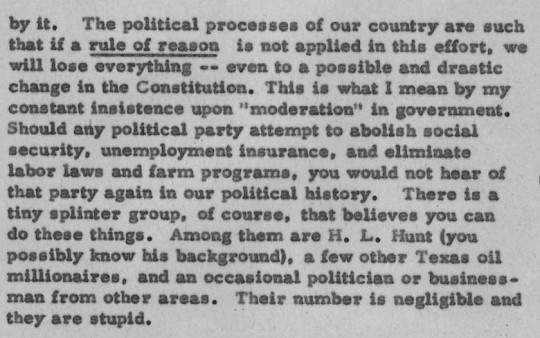
"Rule of Reason" :: Dwight D. Eisenhower
* * * * *
LETTERS FROM AN AMERICAN
May 10, 2024
HEATHER COX RICHARDSON
MAY 11, 2024
On October 31, 2020, former Trump White House advisor Steve Bannon—who had left Trump’s administration in 2017—explained to a group of people that, knowing that votes for Biden would accumulate throughout the evening as mail-in ballots were counted, Trump planned simply to declare victory on election night, seizing the presidency and claiming that any results to the contrary were an attempt to steal the election from him. “[A]t 10 or 11 o’clock Trump’s gonna walk in the Oval, tweet out, ‘I’m the winner. Game over. Suck on that,’” Bannon was recorded as saying.
That prediction was pretty much what happened, but Trump did not succeed in seizing the presidency. Next came plans to overturn the election results, and Bannon was also involved in those. Then, famously, on January 5, 2021, he predicted on his podcast that the next day, “all hell is going to break loose.”
Not surprisingly, the House select committee investigating the January 6, 2021, attack on the U.S. Capitol wanted to talk to Bannon. It subpoenaed him in September 2021 for testimony and documents. When he refused to comply, a jury found him guilty of contempt of Congress in October 2022. A judge sentenced him to four months in jail but allowed him to stay out of jail while he appealed.
Today a three-judge panel of the U.S. Circuit Court of Appeals for the District of Columbia Circuit upheld his conviction. He will not be jailed immediately; he can still appeal to a higher court.
Another White House advisor, Peter Navarro, appealed all the way to the Supreme Court to overturn his own conviction for contempt of Congress after he, too, refused to answer a House subpoena for testimony and documents. The Supreme Court denied his appeal, and Navarro reported to prison on March 19, 2024. He has asked a federal judge to let him serve the remainder of his sentence on supervised release, so far without luck.
Former federal prosecutor and legal analyst Joyce White Vance wrote: “Bannon is effectively out of appeals. He can delay a little bit longer, asking for the full court to review the decision en banc & asking SCOTUS to hear his case on cert, but neither one of those things will happen. Bannon is going to prison.”
Lack of information was at the heart of Bannon and Navarro’s cases; it was also at the heart of the State Department’s report to Congress about whether Israel’s strikes on Gaza have complied with international and U.S. law. National Security Memorandum (NSM)-20, which Biden signed on February 8, 2024, was designed to make sure that there are adequate safeguards and accountability when countries who have access to U.S. weapons use them. The memo required the secretary of state “to obtain certain credible and reliable written assurances from foreign governments receiving defense articles” and transmit that information to Congress.
Issued today, the report covered seven countries in “active conflict”—Colombia, Iraq, Israel, Kenya, Nigeria, Somalia, and Ukraine—and explored whether they were using U.S. government-funded defense articles in accordance with international humanitarian law, and whether they were not “arbitrarily” denying, restricting, or otherwise impeding U.S.-backed humanitarian assistance in any areas where the country was using those U.S. defense articles.
The report noted that it’s hard to collect accurate information in a war zone. Often, the information has to come from participants or third parties, and sometimes that information comes only from the country the U.S. is supplying with weapons. It also noted that the human-rights-based Leahy Laws prohibit the U.S. from supplying weapons to a foreign military unit if the departments of state or defense have credible information that the unit has committed a gross violation of human rights, including torture, rape, extrajudicial killing, or enforced disappearance.
The report concluded that Colombia appears to be in compliance. Iraqi security forces have been credibly alleged to be violating international law, but the U.S. does not supply those units. Those it does supply have received U.S. training on compliance with international humanitarian law, and Iraqi leadership is working closely with the U.S. to professionalize. It has not restricted humanitarian aid.
Kenya has repeatedly violated international human rights law, but it is working to come into compliance and has not misused U.S. weapons. Nigerian forces routinely use excessive force and torture. They are expanding the legal advice in the professionalizing army, and there are no credible reports of U.S. matériel used in ways that are inconsistent with international law.
Somalia has violated humanitarian law and human rights law, arbitrarily killing and torturing people and committing sexual violence. The U.S. supplies the counterterrorism Danab Brigade of the Somali National Army and works closely with it. The State Department assesses that the brigade has not used U.S. weapons in any violations of humanitarian or human rights law.
That leaves Israel and Ukraine.
The report begins by noting that in the October 7 attack on Israel, Hamas and other Palestinian terrorists killed an estimated 1,200 individuals, wounded more than 5,400, and took 253 hostages, including U.S. citizens. Hamas, it notes, “does not follow any portion of and consistently violates” international humanitarian law.
Then it takes on the numbers of Palestinians killed and injured, saying that the Hamas-controlled Gaza Ministry of Health, “which international organizations generally deem credible,” estimates that 34,700 Palestinians have been killed. Another 78,200 have been wounded, “a significant percentage of whom are reported to be women and children.” The Gaza Ministry of Health does not differentiate between Hamas fighters and civilians, but Israel says that about half the 34,700 killed were Hamas fighters. The State Department says that “we do not have the ability to verify this estimate.” It also notes that “[t]he conflict has displaced the vast majority of Palestinians in Gaza and resulted in a severe humanitarian crisis.”
The State Department notes that the U.S. government has emphasized Israeli compliance with international humanitarian law and that Israel has “institutions and processes charged with upholding” those laws. Israel has been conducting assessments, including criminal investigations, into alleged violations of international humanitarian law.
The next paragraph, though, says that when asked, Israel shared some information that gave insight into Israel’s procedures and rules, but that information was incomplete. Among other things, “Israel has not shared complete information to verify whether U.S. defense articles covered under NSM-20 were specifically used in actions that have been alleged as violations of [international humanitarian law or international human rights law] in Gaza, or in the West Bank and East Jerusalem during the period of the report.” However, the authors concluded, because “certain Israeli-operated systems are entirely U.S.-origin (e.g., crewed attack aircraft),” they “are likely to have been involved in incidents that raise concerns about Israel’s [international humanitarian law] compliance.”
The report goes on to say that while it is difficult to determine whether specific U.S. weapons have been used improperly, “there have been sufficient reported incidents to raise serious concerns…. Given the nature of the conflict in Gaza, with Hamas seeking to hide behind civilian populations and infrastructure and expose them to Israeli military action, as well as the lack of [U.S. government] personnel on the ground in Gaza, it is difficult to assess or reach conclusive findings on individual incidents. Nevertheless, given Israel’s significant reliance on U.S.-made defense articles, it is reasonable to assess that defense articles covered under NSM-20 have been used by Israeli security forces since October 7 in instances inconsistent with its [international humanitarian law] obligations or with established best practices for mitigating civilian harm.”
The State Department says it is “not aware” of U.S. weaponry being misused. It also said that it “has had deep concerns…about action and inaction by Israel” that hampered humanitarian aid efforts and that, while that aid still is insufficient, “we do not currently assess that the Israeli government is prohibiting or otherwise restricting the transport or delivery of U.S. humanitarian assistance.”
The report also assessed that Ukraine had occasionally violated international humanitarian law and international human rights law, torturing those suspected of collaborating with Russia, for example. The Ukraine government has committed to adhere to the rule of law. It has apparently not used U.S. weapons in those violations and has facilitated U.S. humanitarian assistance.
LETTERS FROM AN AMERICAN
HEATHER COX RICHARDSON
#Letters From An American#Heather Cox Richardson#rule of law#US Humanitarian assistance#War#war in Ukraine#War in Israle#January 6#2021#Bannon#Insurrection
9 notes
·
View notes
Text
Shaboozey Real Name, Biography Height Age Family and Net Worth


Shaboozey is an American singer-songwriter and musician who was born on May 9, 1995. His 2024 hit song "A Bar Song (Tipsy)" has made him well-known and is currently at the top of music charts in a number of nations worldwide. His distinct musical style, which skillfully combines elements of hip-hop, country, rock, and Americana, has earned him recognition. Read about He his early years, education, career, songs, personal life, net worth, and ethnicity in this article.
Shaboozey Real Name

Shaboozey’s real name, Shabir Awan, reflects his cultural heritage and roots. In order to establish a distinctive persona in the music business. The diverse musical genres he was exposed to while growing up in Lahore. He lyrics are relatable to his audience because they frequently reference personal experiences. The music industry demonstrates his skill and commitment, making him a well-known personality in modern hip-hop.
Shaboozey Biography
Full NameCollins Obinna ChibuezeReal NameShabir AwanDate of BirthMay 9, 1995Place of BirthFairfax, Virginia, USAAge29 (as of 2024)NationalityAmericanEthnicityNigerian-AmericanZodiac SignTaurusFamilyRaised by Nigerian parents; further family details are privateEducationGar-Field High School, Woodbridge, VirginiaCareerSinger, songwriter, producer, and filmmaker Major CollaborationsFeatured on Beyoncé’s Cowboy Carter album (2024),GenresMixes hip-hop, country, rock, and Americana influencesNotable Works“Winning Streak” (2017), “Start a Riot” (2018, featured in Spider-Man: Into the Spider-Verse soundtrack), “A Bar Song (Tipsy)”Net WorthEstimated around $1 million as of 2024HeightApproximately 5 ft 11 inEye ColorBrownHair ColorBlackGenderMaleSocial Media PresenceActive on platforms such as Instagram and Twitter, where he engages fans and promotes his work Shaboozey Early Life, Age and Education

He real name is Collins Obinna Chibueze, was born on May 9, 1995, in Fairfax, Virginia, to Nigerian parents. His early years in Woodbridge, Virginia, were marked by the inspiration he received from watching music videos on 106 & Park. He had a rich tapestry of experiences in his early years. It influenced his distinct creative vision. Discover the origins of his creativity by delving into his past. He is 29 years old as of 2024. He received his formal education in Nigeria at a boarding school. Additionally, he went to Virginia's Garfield High School. Place of Birth and Family

BirthplaceFairfax, VirginiaFamily SupportStrong and EncouragingCultural InfluencesDiverse and Rich He was born in Fairfax, Virginia, a thriving city. His upbringing was significantly influenced by this location. His family served as a vital source of encouragement and support. He has family was influenced by many different cultures. His love of art and music was fostered by his parents. His creative spirit is also shared by his siblings.
Shaboozey Ethnicity
Shaboozey is a Nigerian-American. He was born in the United States while his parents are Nigerian.
Shaboozey Net Worth
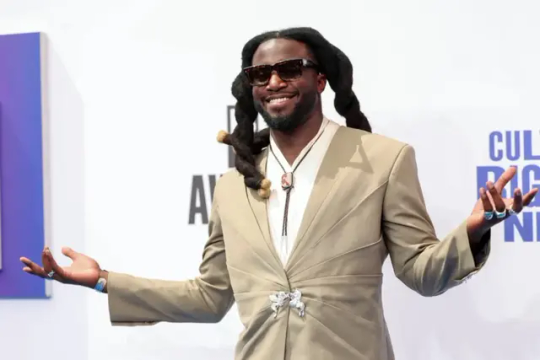
Although Shaboozey's precise net worth has not been made public, industry estimates range from $1 million to $5 million. His music career, which has brought him recognition and a growing fortune, is the main source of his income.
Shaboozey Profession/Career
First Steps In Music

Shaboozey has established a prosperous career as a singer and rapper, renowned for his inventive music and captivating live performances. As he has grown in popularity and recognition over the years, his net worth has increased significantly. He works in a variety of musical fields, such as songwriting and performing. His unique style appeals to a wide range of listeners by fusing elements of modern hip-hop with traditional Pakistani music. He brand and wealth have also increased as a result of his active participation on social media, which has enabled him to interact with fans. Credit - https://www.youtube.com/@shaboozeyvevo Initial Struggles

The music business is hard and competitive, and he had trouble finding his voice. He had a lot of setbacks and rejections. He persisted in his resolve in spite of these obstacles. Every rejection served as a teaching moment for him. He found allies in perseverance and fortitude. The following are some of the main challenges encountered: - Discovering a distinctive sound. - Acquiring recognition in the industry. - Getting past financial obstacles. - How to handle rejection. - Keeping music and personal life in balance. Social Media Profile PlatformLinkWikipediaClick HereInstagramClick Here In conclusion Understanding Shaboozey's character takes on a new meaning after learning his true name. Fans who are aware of this detail feel a stronger bond. For more fascinating information about your favorite musicians, continue exploring. For more information and updates on well-known figures, stay tuned. FAQ Q1. Why is Shaboozey so popular?Ans. Shaboozey so popular combine country with hip-hop feels like a American singer-songwriter and musician rapper, renowned for his inventive music and captivating live performances.Q2. What is Shaboozey full name?Ans. Shaboozey full name is Collins Obinna Chibueze.Q3. When did Shaboozey become famous?Ans. He first gained attention for his 2018 song "Start a Riot," featured on the "Spider-Man: Into the Spider-Verse" soundtrack.Q4. Is Shaboozey country music?Ans. Shaboozey Rising country music star.Q5. What is Shaboozey net worth of 2024?Ans. He his estimates net worth range from $1 million to $5 million as of 2024.Q6. What is Shaboozey height and weight?Ans. Shaboozey is 5”11 “ height and his weight is 70 kg approximately. Also Read: - Ruby Drew Biography, Age, Height, Wiki, Net Worth, Boyfriend - Sophie Reynolds Biography, Height, Age, Family, Boyfriend and Net Worth - Sarah Drew Biography, Height, Age, Family, Boyfriend and Net Worth - Stephanie Poetri Biography, Height, Age, Family, Boyfriend and Net Worth - Leslie Mann Biography, Height, Age, Family, Boyfriend and Net Worth Read the full article
3 notes
·
View notes
Text
Holidays 1.29
Holidays
Axe Day (French Republic)
Battle of Kruty Anniversary Day (Ukraine)
Blue and Pink Day
Bowling Green Massacre Day
Bubblegum Sculpture Day
Common Sense Day
Curmudgeons’ Day
Feast of Overdue Expectations
Fields Day
Freethinkers’ Day
Gab Union Appreciation Day
Hall of Fame Day (MLB)
Holiday of the Three Hierarchs (Greece)
I Don’t Like Mondays Incident Anniversary Day
Independent Hotel Day
Jigsaw Puzzle Day
Kansas Day (Kansas)
Martyr’s Day (Nepal)
Milton Friedman Day (California)
Motorwagen Day
National Appreciation Day for Catholic Schools
National Day of Remembrance for the Quebec City Mosque Attack (Canada)
National Lady Gaga Day
National Police Anniversary Day (Philippines)
National Puzzle Day
National Trans Visibility Day (Brazil)
Nevermore Day
Oprah Winfrey Day
Prosecutor’s Day (Moldova)
RNLI SOS Day (UK)
Romeo and Juliet Day
Sahid Diwash (Martyrs’ Day; Nepal)
Seeing Eye Dog Day
Thomas Paine Day
Victoria Cross Day
World Automobile Day
Food & Drink Celebrations
Arak Bali Day (Bali)
Gnocchi Day (Argentina)
National Corn Chip Day
Pork Belly Day
Potato Day
Sugar Cone Day
Weisse Beer Day
Nature Celebrations
Carnation Day (a.k.a. Red Carnation Day)
Moss Day (Mother’s Love; Korean Birth Flowers)
Independence, Flag & Related Days
Constitution Day (Gibraltar)
Grand Republic of Hugia (Declared; 2019) [unrecognized]
Kansas Statehood Day (#34; 1861)
Larsonia (Declared; 2017) [unrecognized]
New Year’s Days
Kebbawa New Year & Beginning of Fishing Season (Kebbawa People of Nigeria)
New Year's Day [Lunar Calendar] (a.k.a. …
Bituun (Mongolia)
Chinese New Year [2024: Year of the Dragon]
Chinese Zodiac: Year of the Yin Black Water Rabbit
Fete du Printemps (Mauritius)
Losar/Loshar (India, Nepal)
Lunar New Year’s Day (Hong Kong)
Novo Ano Lunar (Macau)
Seol-Nal (South Korea)
Sonam Lhosar (Tamang New Year)
Sonam Lochhar (Sikkam, India)
Spring Festival (China)
Tahun Baru Imlek (Indonesia)
Tamang New Year (Nepal)
Tet Nguyen Dan (Vietnam)
Tsagaan Sar (Mongolia) [2025: Year of the Blue Snake]
Tet Holiday begins (Vietnam)
5th & Last Wednesday in January
Bell Let’s Talk Day (Canada) [Last Wednesday]
Hump Day [Every Wednesday]
Wacky Wednesday [Every Wednesday]
Website Wednesday [Every Wednesday]
Whole Grain Wednesday [Last Wednesday of Each Month]
Wishful Wednesday [Last Wednesday of Each Month]
Weekly Holidays beginning January 29 (Last Week of January)
Chinese New Year Festival (San Francisco, California) [thru 2.16]
Festivals Beginning January 29, 2025
Chinese New Year Festival and Parade (San Francisco, California) [thru 2.16]
Emirates Airline Festival of Literature (Dubai, UAE) [thru 2.3]
Gérardmer Fantastic Film Festival (Gérardmer, France) [thru 2.2]
La Folle Journée (Nantes, France) [thru 2.2]
Riviera Maya with Phish (Cancun, Mexico) [thru 2.1]
Feast Days
Andrei Rublev (Episcopal Church (USA))
Anton Chekov (Writersim)
Aquilinus of Milan (Christian; Saint)
Blue and Pink Day (Shamanism)
Charge Candles by Moonlight Day (Starza Pagan Book of Days)
Concordia I: Irene’s Day (Pagan)
Constantius of Perugia (Christian; Saint)
Curmudgeons Day (Pastafarian)
Dallán Forgaill (Christian; Saint)
Edward Abbey (Writersim)
The Equiria in the Campus Martius (a.k.a. The Pacalia; Ancient Rome)
Francis de Sales (Christian; Saint)
Gamelion Noumenia (Festival to All Gods & Goddesses; Ancient Greece)
Gildas the Albanian or Scot or the Wise (Christian; Saint)
Gildas the Wise (a.k.a. Badoncius; Christian; Saint)
Happy Hedgehog Day (Pastafarian)
Hesiod (Positivist; Saint)
House Blessing Day (Celtic Book of Days)
Juniper (Christian; Saint)
Paddy Chayefsky (Writersim)
Parade of the Unicorns (Everyday Wicca)
Romain Rolland (Writerism)
Sabinian of Troyes (Christian; Saint)
Sabrina T. Pagebottom (Muppetism)
Sulpicius Severus (Christian; Saint)
Sulpitius I of Bourges (Christian; Saint)
Theo Wujcik (Artology)
Valerius of Trèves (Christian; Saint)
Valero’s Feast (Spain; Saint)
Vasant Panchami (Celebrating Saraswati, Hindu goddess of knowledge)
Willy Wonka Day (Church of the SubGenius; Saint)
Lunar Calendar Holidays
Chinese: Month 1 (Wu-Yin), Day 1 (Wu-Xu)
Day Pillar: Earth Dog
12-Day Officers/12 Gods: Receive Day (收 Shou) [Inauspicious]
Holidays: New Year’s Day
Secular Saints Days
Daniel Bernoulli (Mathematics)
Giuliano Bugiardinii (Art)
Edward Burns (Entertainment)
Patrick Caulfield (Art)
Paddy Chayefsky (Literature)
Anton Chekov (Literature)
Frederick Delius (Music)
Heather Graham (Entertainment)
Bernar Herrmann (Music)
Ernst Lubitsch (Entertainment)
Victor Mature (Entertainment)
Barnett Newman (Art)
Carl Nielsen (Music)
Bill Peet (Art)
Henry Ward Ranger (Art)
Romain Rolland (Literature)
Katherine Ross (Entertainment)
Tom Selleck (Entertainment)
Emanual Swedenborg (Polymath)
Samuel Worcester Rowse (Art)
Peter Voulkos (Art)
Brian Wood (Art)
Lucky & Unlucky Days
Lucky Day (Philippines) [6 of 71]
Prime Number Day: 29 [10 of 72]
Sensho (先勝 Japan) [Good luck in the morning, bad luck in the afternoon.]
Tycho Brahe Unlucky Day (Scandinavia) [7 of 37]
Very Unlucky Day (Grafton’s Manual of 1565) [8 of 60]
Premieres
The Adventures of Hardrock Dome (Paramount-Bray Pictographs Cartoon; 1919)
Alice, by Avril Lavigne (Song; 2010)
All My Sons, by Arthur Miller (Play; 1947)
All Quiet on the Western Front, by Erich Maria Remarque (Novel; 1929)
American League (Professional Baseball League; 1900)
Awful Orphan (WB MM Cartoon; 1949)
Baseball Hall of Fame (Sports Organization; 1936)
Batman: The Dark Knight Returns Pt. 2 (WB Animated Film; 2013)
The Beggar’s Opera, by John Gay (Ballad Opera; 1728)
Charlie in Turkey (Charlie Movca Film Service Cartoon; 1919)
Common Sense, by Thomas Paine (Pamphlet; 1737)
Desert Island Discs (UK BBC Radio Series; 1942)
Donald’s Tire Trouble (Disney Cartoon; 1943)
Doorway to Danger or Doom in the Room (Rocky & Bullwinkle Cartoon, S2, Ep. 94; 1961)
Dr. Jekyll and Mr. Hyde, by Robert Louise Stevenson, adapted by J. Comyn’s Carr (Play; 1910)
Dr. Strangelove or: How I Learned to Stop Worrying and Love the Bomb (Film; 1964)
Everything I Own, by Bread (Song; 1972)
Fantasia (Animated Disney Film; 1941)
Faust, complete play, by Goethe (Play; 1829)
Hunky and Spunky in ‘Always Kickin’’ (Fleischer Color Classics Cartoon; 1939)
I Fought the Law, by the Bobby Fuller Four (Song; 1966)
I Should Never Have Told You (Fleischer Screen Songs Cartoon; 1937)
I Want to Hold Your Hand / She Loves You, recorded in German by The Beatles (Songs; 1964)
Komm Gib Mir Deine Hand/Sie Liebt Dice, recorded by The Beatles (Songs in German; 1964)
Kung Fu Panda 3 (Animated Film; 2016)
Matinee (Film; 1993)
Meatless Flyway (WB MM Cartoon; 1944)
Million Dollar Carton or Jack in the Box (Rocky & Bullwinkle Cartoon, S4, Ep. 199; 1963)
My Little Buckaroo (WB MM Cartoon; 1938)
Out and Out Rout (WB MM Cartoon; 1966)
Peaceful Neighbors (Color Rhapsody; 1939)
Pests for Guests (WB MM Cartoon; 1955)
The Raven, by Edgar Allan Poe (Poem; 1845)
Rock-a-Bye Gator (Woody Woodpecker Cartoon; 1962)
Say It with Flowers (Color Rhapsody Cartoon; 1943)
Scrappy’s Television (Scrappy Cartoon; 1934)
Scythian Suite, by Sergei Prokofiev (Orchestral Suite; 1916)
The Seapreme Court (Noveltoons Cartoon; 1954)
She’s All That (Film; 1999)
Skelton Frolic (Ub Iwerks Color Rhapsody Cartoon; 1937)
Sketchbook of Chicago (Vernon Howe Bailey’s Sketchbook Cartoon; 1916)
Sleeping Beauty (Animated Disney Film; 1959)
So Into You, by the Atlantic Rhythm Section (Song; 1977)
Somebody to Love, by The Great Society (Song; 1978)
Superman in the Mummy Strikes *Fleischer/Famous Superman Cartoon; 1943)
Two at One Blow or The Devil Beheader (Rocky & Bullwinkle Cartoon, S4, Ep. 200; 1963)
Up at the Villa, by W. Somerset Maugham (Novella; 1941)
Victoria Cross (UK Order awarded for Bravery; 1856)
White Rabbit, by The Great Society (Song; 1978)
Window Pains or The Moosetrap (Rocky & Bullwinkle Cartoon, S2, Ep. 93; 1961)
The Wonder Gloves (Jolly Frolics UPA Cartoon; 1951)
Working My Way Back to You, by the Four Seasons (Song; 1966)
Today’s Name Days
Gerd, Gerhard, Josef, Valerius (Austria)
Tvrtko, Valerije, Zdeslav, Zdravko (Croatia)
Zdislava (Czech Republic)
Valerius (Denmark)
Valmo, Valter (Estonia)
Valtteri (Finland)
Gildas (France)
Gerd, Gerhard, Josef (Germany)
Varsamia (Greece)
Adél (Hungary)
Aquilino, Costanzo, Valerio, Vitale (Italy)
Aivars, Valērijs (Latvia)
Aivaras, Girkantas, Valerijus, Žibutė (Lithuania)
Herdis, Hermann, Hermod (Norway)
Franciszek Salezy, Gilda, Hanna, Walerian, Waleriana, Waleriusz, Zdzisław (Poland)
Ignatie (Romania)
Gašpar (Slovakia)
Valerio, Valero (Spain)
Diana (Sweden)
Gilda, Goldie, Sheldon, Shelley, Shelly, Shelton, Ophrah, Oprah (USA)
Today’s National Name Days
National Colin Day
Today is Also…
Day of Year: Day 29 of 2025; 336 days remaining in the year
ISO Week: Day 3 of Week 5 of 2025
Celtic Tree Calendar: Luis (Rowan) [Day 9 of 28]
Chinese: Month 1 (Wu-Yin), Day 1 (Wu-Xu)
Chinese Year of the: Snake 4723 (until February 17, 2026) [Ding-Chou]
Coptic: 21 Tubah 1741
Druid Tree Calendar: Cypress (Jan 25-Feb 3) [Day 5 of 15]
Hebrew: 29 Teveth 5785
Islamic: 29 Rajab 1446
J Cal: 29 White; Eighthday [29 of 30]
Julian: 16 January 2025
Moon: 0%: New Moon
Positivist: 1 Homer (2nd Month) [Hesiod)
Runic Half Month: Elhaz (Elk) [Day 8 of 15]
Season: Winter (Day 40 of 90)
Week: 4th & Last Week of January
Zodiac:
Tropical (Typical) Zodiac: Aquarius (Day 10 of 30)
Sidereal Zodiac: Capricorn (Day 15 of 29)
Schmidt Zodiac: Capricorn (Day 4 of 27)
IAU Boundaries (Current) Zodiac: Capricorn (Day 10 of 28)
IAU Boundaries (1977) Zodiac: Capricornus (Day 11 of 28)
Calendar Changes
Homer (Ancient Poetry) [Month 2 of 13; Positivist]
陬月 [Zōuyuè] (Chinese Lunisolar Calendar) [Month 1 of 12] (Square of Pegasus Month; Corner Month) [Earthly Branch: Tiger Month] (Modern Name: zhēngyuè; First Month)
2 notes
·
View notes
Text
11 Meaningful Pieces In Catherine’s Jewellery Collection That Belonged To Queen Elizabeth II
By Emily Chan
6 December 2023
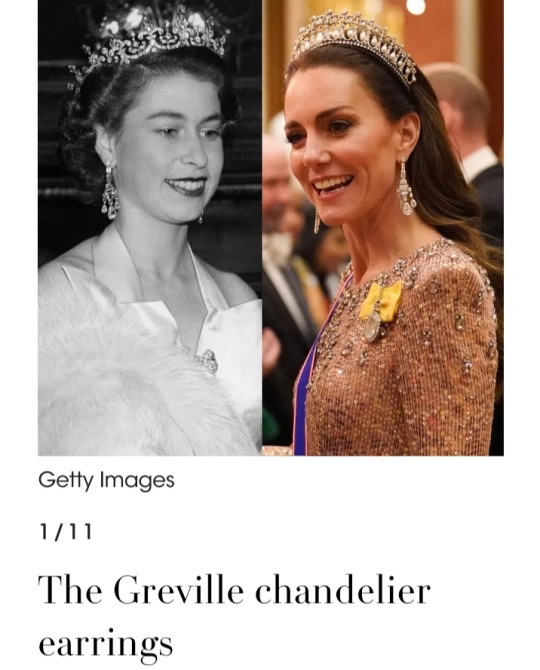
First worn by the Princess of Wales in June at the wedding of Crown Prince Hussein of Jordan and Princess Rajwa Al Saif in Amman, Jordan, the Greville chandelier earrings were seen on Queen Elizabeth II throughout her reign.
The dazzling diamond earrings made by Cartier were a wedding gift to Her late Majesty from her parents – the Queen Mother had inherited them from Dame Margaret Helen Greville, a British socialite, in 1918.
Catherine was most recently seen wearing the jewels at a Diplomatic Corps reception at Buckingham Palace.
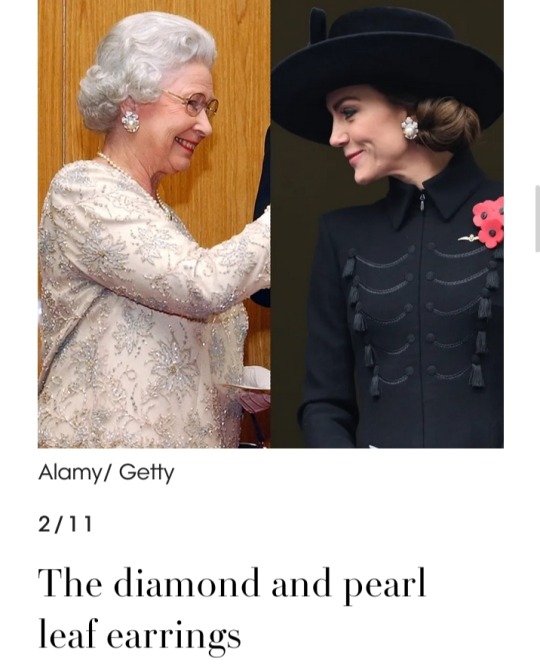
On Remembrance Sunday this year, Catherine debuted a pair of diamond and pearl leaf earrings that were previously seen on the Queen during a visit to Nigeria back in 2003.
Some experts believe that the earrings may have been detachable pieces from the brooch featuring the same design.

Commissioned by King George VI, Queen Elizabeth II’s Festoon necklace features 105 loose diamonds that her father inherited when he ascended the throne.
Featuring three strands, the monarch wore the piece on numerous occasions throughout her life, from attending state banquets to posing for official portraits.
The Princess of Wales paid tribute to Her late Majesty by wearing the piece for the official Coronation photograph when King Charles III officially assumed the throne on 6 May.
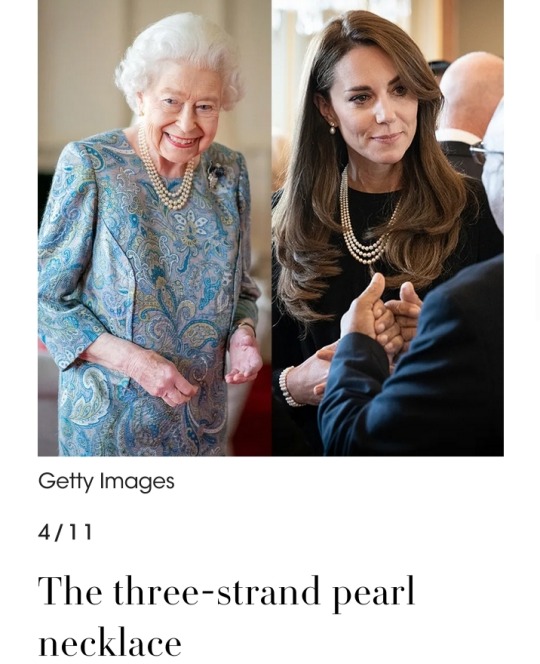
The Princess of Wales wore Queen Elizabeth II’s three-strand pearl necklace – an item Her Majesty was famous for – during a Buckingham Palace lunch for the governors-general of the Commonwealth nations prior to the monarch’s funeral in September 2022.
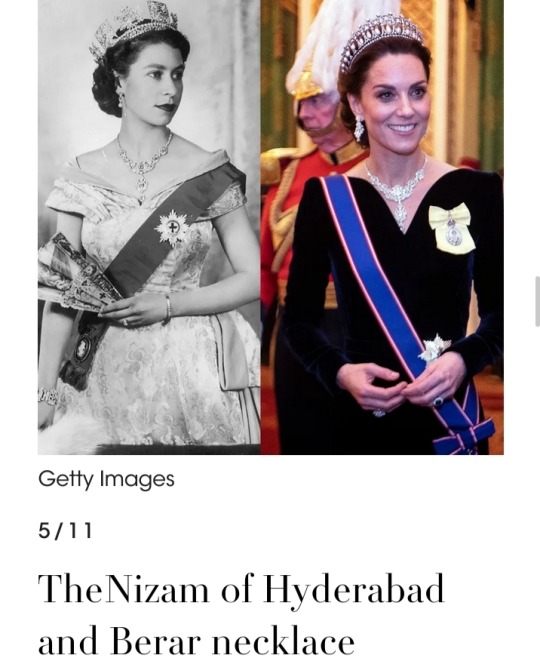
The then Princess Elizabeth received this jaw-dropping diamond necklace by Cartier from the Nizam of Hyderabad as a wedding gift in 1947.
Featuring a rose motif, the royal picked the necklace herself, along with a matching floral tiara.
The Princess of Wales first wore the statement piece at a gala for the National Portrait Gallery in 2014, before rewearing it at a Buckingham Palace reception for the Diplomatic Corps in 2019.

Queen Elizabeth II was first photographed wearing these diamond and pearl earrings during her Silver Jubilee celebrations – marking 25 years on the throne – in 1977.
Catherine has sported the earrings a number of times in the past, including after Prince Louis’ birth in 2018 and while visiting Commonwealth troops ahead of the Queen’s funeral.
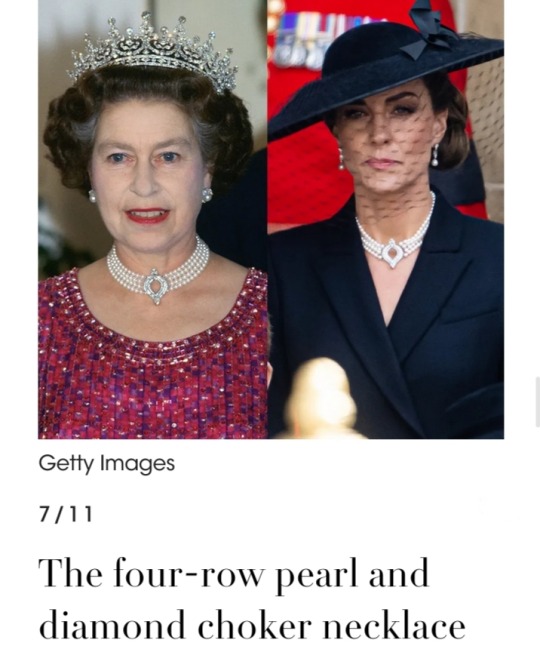
Queen Elizabeth II commissioned royal jeweller Garrard to create this four-strand pearl and diamond choker, using pearls sourced from Japan in the early 1980s.
Princess Diana was loaned the piece for a state banquet in honour of Queen Beatrix of the Netherlands in 1982, while the current Princess of Wales has worn the necklace on several occasions, including for Queen Elizabeth and Prince Philip’s 70th wedding anniversary in 2017 and Her Majesty’s funeral in 2022.
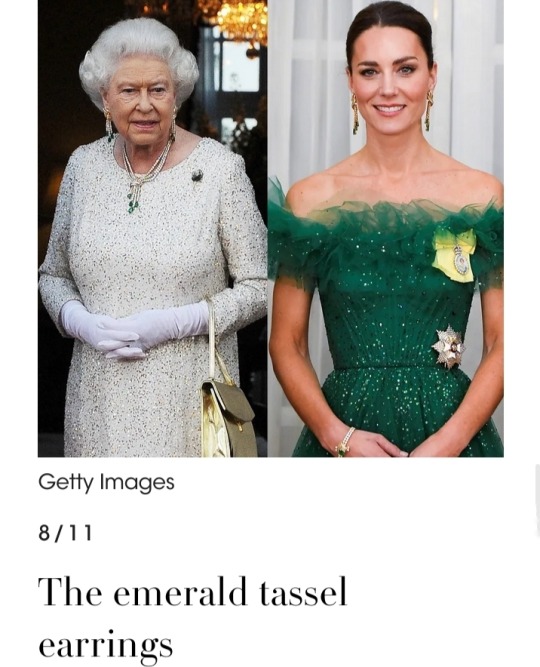
The Princess of Wales debuted Queen Elizabeth II’s emerald and diamond earrings during an evening reception in Jamaica in 2022, along with a matching bracelet.
Both pieces are from Her late Majesty’s emerald tassel suite, which the monarch first wore at a state dinner held for Sheikh Zayed bin Sultan Al Nahyan of the United Arab Emirates at London’s Claridge’s Hotel in 1989.

First worn by Queen Elizabeth II during the 1990s, the Princess of Wales has borrowed Her late Majesty’s diamond and pearl leaf brooch a number of times over the years, including on a visit commemorating the Battle of Passchendaele in Belgium in 2017.
Catherine wore the piece in tribute to the monarch while attending her funeral procession at Westminster Hall in September 2022.

The sapphire and diamond earrings
The Princess of Wales borrowed Queen Elizabeth’s sapphire and diamond earrings for a visit to Edinburgh in 2021.
The sapphire earrings are part of a suite of sapphire and diamond jewellery by Asprey, which Her late Majesty added to her collection during the late 1970s.
The Bahrain pearl drop earrings
Featuring two pearls gifted to Her late Majesty by the Hakim of Bahrain as a wedding present, these diamond and pearl drop earrings were also worn by Princess Diana in the 1980s.
The Princess of Wales was first spotted wearing the earrings at a Remembrance Day service in 2016, before going on to wear them for Trooping the Colour in 2019 and Queen Elizabeth II’s funeral in 2022.
#Queen Elizabeth II#Princess of Wales#Catherine Princess of Wales#Catherine Middleton#Kate Middleton#British Royal Family#jewelries#Jewellery Collection
12 notes
·
View notes
Text



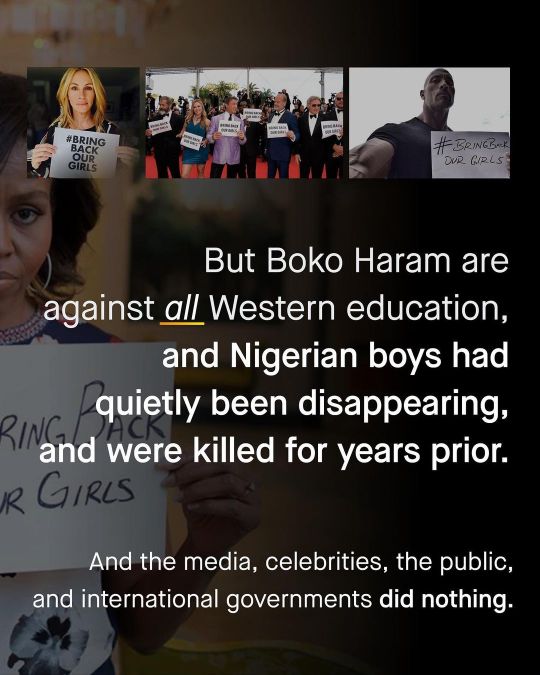

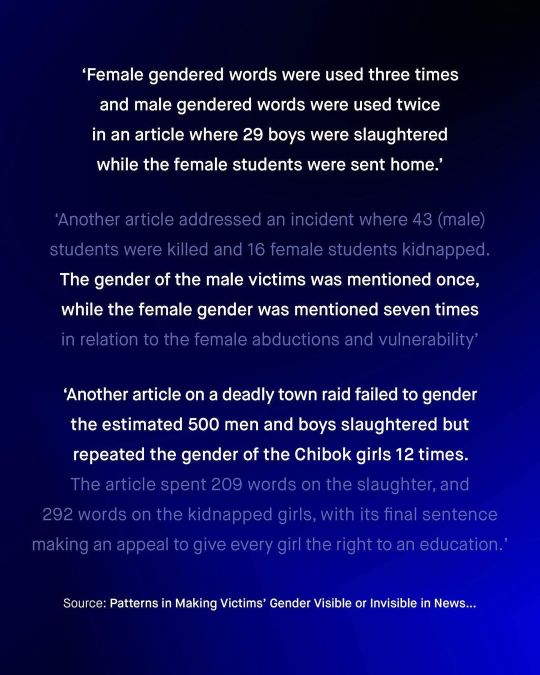

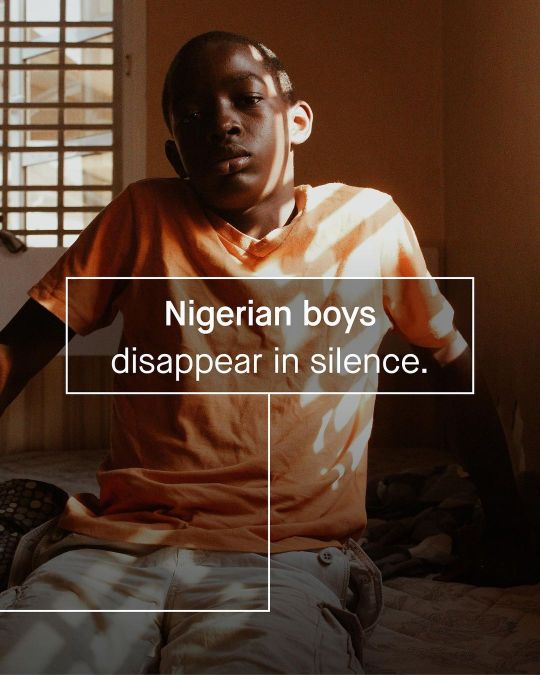
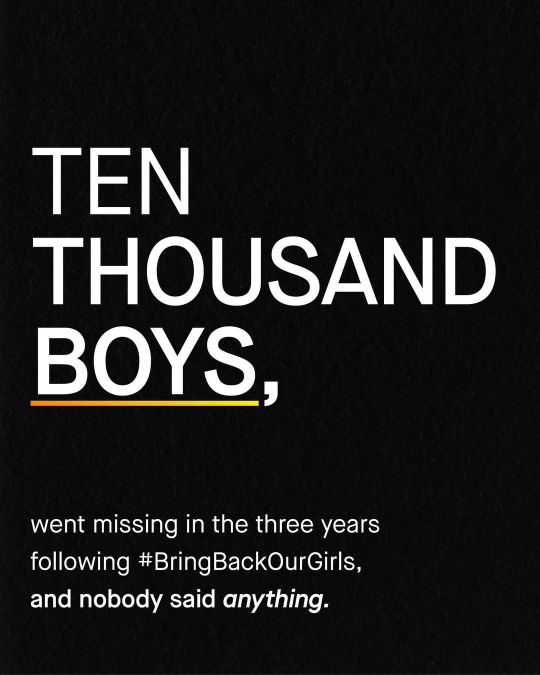
Just because you don’t hear about something, doesn’t mean it isn’t happening.
Because tragically, too often, boys and men suffer in darkness.
There is perhaps no better example of this than the horrific actions of Boko Haram, and the countless boys and men they have taken, without trace, and to very little outrage.
For it is not just the education of women and girls that the group are implacably against, Boko Haram are against all Western education, for all people, including men and boys.
For years they demonstrated this through enacting unspeakable war crimes onto innocent Nigerian men and boys, often releasing women and girls, and for years they were ignored by a disinterested world.
Boys disappeared. Men were killed. Nobody said anything.
And certainly nobody especially important.
Then things changed in April 2014, when nearly 300 Nigerian girls were taken, and the world woke up to what was going on.
Celebrities marched the red carpets, political leaders spoke up, Michelle Obama fought for justice, god damn, we had China and America working together for once.
#bringbackourgirls rang out, as it should, and the much awaited outrage and long overdue horror finally took flight.
Most of the girls were saved, and the world went about its business as usual…
The following three years saw not 300 boys taken, or 500… but 10,000, and as before, silence reined supreme.
So who will speak for these forgotten boys?
Who will bring back all Nigeria’s children?
~
Study: https://ijoc.org/index.php/ijoc/article/view/20829/4320
Patterns in Making Victims’ Gender Visible or Invisible in News Media Reporting of Boko Haram’s Massacres and Kidnappings
Boko Haram, a terrorist group based in Nigeria, has systematically conducted gender- based mass kidnappings and killings throughout its history, and these gendered crimes have included both male and female victims. This research examined newspaper articles on Boko Haram’s gendered crimes reported from July 2013 to February 2021, with a focus on the relative visibility of the gender of the victims. The genders of male and female abductees were clearly identified; however, the gender of male massacre victims was relatively invisible irrespective of whether they were men or boys. A failure to report the gendered nature of the massacres may contribute to lower awareness and, thus, reduced security resourcing needed to address such severe human rights violations.
--
The name Boko Haram can be loosely translated as “Western education is sin” (Sergie & Johnson, 2014, para. 4). The group has strongly advocated radical social and educational reforms throughout Nigeria (Bello, 2021), aiming at eliminating all Western influences and replacing Western education and standards with “undiluted” Islamic laws and procedures that are identical to Sharia. Boko Haram might have deemed offensive any consideration of improving women’s empowerment through education instead of seeing it as a key issue of human rights and development. Thus, in April 2014, the group gained international notice and notoriety for the kidnapping of 276 schoolgirls and the subsequent #BringBackOurGirls campaign promoted by the then First Lady of the United States, Michelle Obama. The crime garnered international outrage and support to seek the return of the girls, of which at the time of publishing, 90 were still missing (Lewis, 2023). Boko Haram also used female kidnapping and suicide bombers as part of its strategy to increase its media coverage (Zenn & Pearson, 2014).
The gendered nature of Boko Haram’s tactics was used before and after the Chibok kidnapping. Boko Haram has committed gender-selective kidnappings and executions against adults and children throughout much of its history. This insurgent group is believed to have kidnapped up to an estimated 10,000 boys and men to be forcibly conscripted or enslaved (Hinshaw & Parkinson, 2016; Topol, 2017) and kidnapped hundreds of women and girls for pressured conversions to Islam, to marry Boko Haram combatants, to be used for sexual and domestic enslavement, or to be used for tactical strategy (Amnesty International, 2015; Omilusi, 2015; Zenn & Pearson, 2014). While Boko Haram has also engaged in bombings where the killing has been more indiscriminate or done based on religion or engagement in secular education, a significant portion of the abductions and killings were gender based.
Academic literature to date has addressed Boko Haram’s gendered crimes with an almost exclusive focus on women, girls, and children. Barkindo, Gudaku, and Wesley (2013) report on Boko Haram’s violence against Christian women and girls, defining gender-based violence as that conducted by males or male institutions against women and girls, thus definitionally excluding recognition of boys and men as victims. Pereira (2018) and Zenn and Pearson (2014) directed their attention to female victims of Boko Haram’s violence and briefly mentioned that insurgent violence is also directed toward men and boys. Pogoson and Saleh (2019) focused on female vulnerability to violence in Nigeria and argued that Nigeria’s security forces needed to prioritize the protection of women from violence. When discussing Boko Haram’s and al Shabaab’s1 tactics, Matfess (2020) omitted any mention of men and boy victims and compared the violence toward women with violence against civilians, thus comparing female gender identity with noncombatant identities. A report of the Office of the United Nations High Commissioner for Human Rights (2015) on Boko Haram mostly excluded recognizing men and boys as victims of this gender-based violence while also acknowledging in other parts that men and boys were specifically targeted to be murdered or kidnapped. Likewise, Boukhars (2020) identified Boko Haram’s gendered crimes as being solely about the kidnappings of women and girls. In an edited book titled Boko Haram and International Law (Iyi & Strydom, 2018), a section containing three chapters focused on the welfare of girls and women in the conflict while the entire book mentioned the word “boys” a total of three times in reference to incidents of their victimization. The Boko Haram academic gendered victim discourse and analysis relates almost exclusively to females and tends to exclude males. To date, there appears little attention and acknowledgment of the civilian male victims in the literature or discourse.
==
"Male privilege" is when nobody noticed or cares that you're dead or missing.
#Boko Haram#bring back our girls#bring back our boys#islam#sharia#male disposability#gendered violence#gamma bias#male victims#religion is a mental illness
17 notes
·
View notes
Text
Kano, Nigeria — Authorities in northern Nigeria's largest city have begun evacuating more than 5,000 street children seen as a "security threat" and a growing concern as an economic crisis forces more to fend for themselves. The Hisbah, a regional police force tasked with enforcing Islamic Sharia law, have carried out midnight raids on motor parks, markets and street corners in the regional capital, Kano, since the beginning of the year, evacuating children as they sleep.
"We have so far mopped up 300 of these boys from the streets and taken them into a camp provided for their rehabilitation," Hisbah's director-general Abba Sufi told AFP. "Their continued living on the streets is a huge social and security threat because they are potential criminal recruits."
"They are a ticking time bomb that needs to be urgently defused with tact and care," said Sufi.
In November, Kano State governor Abba Kabir Yusuf set up a committee to rid the city of the street children, most of whom are boys. Many sleep in the open and have no access to education or parental care.
With the highest divorce rate in Nigeria, according to official figures, Kano is dealing with a surge in children from broken homes.
Largely left to fend for themselves, the boys roam the city, begging, selling items at traffic lights and scavenging for scrap metal to sell to get money to feed themselves.
The west African economic powerhouse faces its worst economic crisis in decades, with inflation soaring to 34.6 percent in November, leaving many struggling to eat.
Nigeria has 18.5 million out-of-school children, with Kano State accounting for 1.9 million, the highest rate in the country, according to the United Nations Children's Fund (UNICEF) in a 2022 survey.
The Kano figure accounts for 39% of the total number of children living in the state, the 2022 Nigeria Multidimensional Poverty survey said.
With the highest divorce rate in Nigeria, according to official figures, Kano is dealing with a surge in children from broken homes.
Largely left to fend for themselves, the boys roam the city, begging, selling items at traffic lights and scavenging for scrap metal to sell to get money to feed themselves.
The west African economic powerhouse faces its worst economic crisis in decades, with inflation soaring to 34.6 percent in November, leaving many struggling to eat.
Nigeria has 18.5 million out-of-school children, with Kano State accounting for 1.9 million, the highest rate in the country, according to the United Nations Children's Fund (UNICEF) in a 2022 survey.
The Kano figure accounts for 39% of the total number of children living in the state, the 2022 Nigeria Multidimensional Poverty survey said.
Officials told AFP that many of the children in Kano city came from neighboring states.
"Some of them are from Kano, while others are from other states," said Hisbah commander Aminu Daurawa. "The first step is profiling them and identifying where they came from."
Some were sent from villages to learn how to read the Koran at informal Islamic religious schools called almajiri. Residents said many students of the Koranic schools beg for food and alms between classes.
Attempts by authorities and local groups to intervene and support the age-old almajiri system have faced opposition from traditional clerics.
The Hisbah police plan to provide "psychosocial" support and counselling to the children before enrolling those who show interest in school, Sufi said, adding that others will be given seed money to start a trade of their choice.
Daurawa told AFP that out-of-state children will be repatriated after their rehabilitation.
Previous attempts to clear the city of street children have failed.
Between 2017 and 2018, the Hisbah evacuated some 26,000 children and reunited them with their parents in and outside Kano, but they returned to the streets after a lull, according to Daurawa.
During the COVID-19 pandemic, authorities in Kano shut almajiri schools and transported the pupils to their states, but they returned when the schools reopened.
"We want to avoid a repeat of the past experience, which is why we changed approach by camping the children and rehabilitating them before sending them back into the society," Sufi said.
3 notes
·
View notes
Text
More Nigeria shenanigans at Save the Children UK... by u/Cuntributor
More Nigeria shenanigans at Save the Children UK... ....which is apparently a charity that Princess Anne has been Patron of since 2017. From what I can gather, the dumb idiots were invited there by Misan "I Photoshop Shit Badly" Harriman because he's involved with the charity somehow? I don't care to find out, don't give a shit about that dude. Such a shame that charities still involve themselves with these two morons. Also, I cannot read the words "survive but thrive" without gagging. Link to post on X: https://twitter.com/savechildrenuk/status/1791017096664564006Look at me faux Royalling!!! Look at MEEEEE!!!! post link: https://ift.tt/TFVh35o author: Cuntributor submitted: May 16, 2024 at 05:49PM via SaintMeghanMarkle on Reddit disclaimer: all views + opinions expressed by the author of this post, as well as any comments and reblogs, are solely the author's own; they do not necessarily reflect the views of the administrator of this Tumblr blog. For entertainment only.
#SaintMeghanMarkle#harry and meghan#meghan markle#prince harry#fucking grifters#Worldwide Privacy Tour#Instagram loving bitch wife#duchess of delinquency#voetsek meghan#walmart wallis#markled#archewell#archewell foundation#megxit#duke and duchess of sussex#duke of sussex#duchess of sussex#doria ragland#rent a royal#sentebale#clevr blends#lemonada media#archetypes with meghan#invictus#invictus games#Sussex#WAAAGH#american riviera orchard#Cuntributor
4 notes
·
View notes